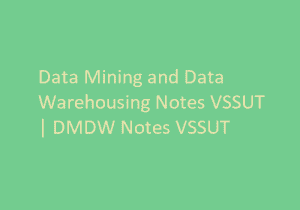Data Warehousing And Data Mining Lecture Notes Pdf

In the last years, data warehousing has got attention from Universities which are now. Keywords: Business intelligence system; decision making; data warehouse architecture. Been solved by comparing names with those in CWA and by using a data mining algorithm for. Results according to the csv or pdf formats. Prezioso.
Data Warehouse Understanding a Data Warehouse • A data warehouse is a database, which is kept separate from the organization’s operational database. • There is no frequent updating done in a data warehouse. • It possesses consolidated historical data, which helps the organization to analyze its business.
• A data warehouse helps executives to organize, understand, and use their data to take strategic decisions. • Data warehouse systems help in the integration of diversity of application systems. • A data warehouse system helps in consolidated historical data analysis.
Data Warehouse Applications As discussed before, a data warehouse helps business executives to organize, analyze, and use their data for decision making. A data warehouse serves as a sole part of a plan-execute-assess “closed-loop” feedback system for the enterprise management. Data warehouses are widely used in the following fields: • Financial services • Banking services • Consumer goods • Retail sectors • Controlled manufacturing For full Notes click the below Link.
DWDM Latest Material Links DWDM Old Material Links Please find the more DWDM ppt Notes files download links below UNIT – I • Introduction: Fundamentals of data mining, Data Mining Functionalities, Classification of Data Mining systems, Major issues in Data Mining. • Data Preprocessing: Needs Preprocessing the Data, Data Cleaning, Data Integration and Transformation, Data Reduction, Discretization and Concept Hierarchy Generation. UNIT – II • Data Warehouse and OLAP Technology for Data Mining Data Warehouse, Multidimensional Data Model, Data Warehouse Architecture, • Data Warehouse Implementation, Further Development of Data Cube Technology, From Data Warehousing to Data Mining. Data cube computation and Data Generalization: • Efficient methods for Data cube computation, Further Development of Data Cube and OLAP Technology, Attribute Oriented Induction. UNIT – III • Mining Frequent Patterns, Associations And Correlations, Basic Concepts. Efficient And Scalable Frequent Itemset Mining Methods Mining Various Kinds Of Association Rules, • From Associative Mining To Correlation Analysis, Constraint Based Association Mining. UNIT – IV • Classification and Prediction: Issues Regarding Classification and Prediction, Classification by Decision Tree Induction, • Bayesian Classification, Classification by Backpropagation, Support Vector Machines, Associative Classification, Lazy Learners, • Other Classification Methods, Prediction, Accuracy and Error Measures, Evaluating the accuracy of Classifier or a predictor, Ensemble methods.
UNIT – V • Cluster Analysis Introduction: Types of Data in Cluster Analysis, A Categorization of Major Clustering Methods, • Partitioning Methods, Density-Based Methods, Grid-Based Methods, Model-Based Clustering Methods, Outlier Analysis. UNIT – VI • Mining Streams, Time Series and Sequence Data: Mining Data Streams Mining Time Series Data, Mining Sequence Patterns in Transactional Databases, • Mining Sequence Patterns in biological Data, Graph Mining, Social Network Analysis and Multi Relational Data Mining UNIT – VII • Mining Object, Spatial, Multimedia, Text and Web Data: Multidimensional Analysis and Descriptive mining of Complex Data objects, Spatial Data Mining, Multimedia Data Mining, Text Mining, Mining of the World WideWeb. UNIT – VIII • Applications and Trends In Data Mining: Data mining applications, Data Mining Products and Research Prototypes, Additional Themes on Data Mining and Social Impacts Of Data Mining. TEXT BOOKS: • Data Mining – Concepts and Techniques – JIAWEI HAN & MICHELINE KAMBER Harcourt India.2nd ed 2006 • introduction to data mining- pang-ning tan, micheal steinbach and vipin kumar, pearson education.
REFERENCES: • Data Mining Introductory and advanced topics –MARGARET H DUNHAM, PEARSON EDUCATION • Data Mining Techniques – ARUN K PUJARI, University Press. • Data Warehousing in the Real World – SAM ANAHORY & DENNIS MURRAY. Pearson Edn Asia.
• Data Warehousing Fundamentals – PAULRAJ PONNAIAH WILEY STUDENT EDITION. • The Data Warehouse Life cycle Tool kit – RALPH KIMBALL WILEY STUDENT EDITION.